Michael Wolf’s Penetrating Lens
January 6th, 2009Last week I went to 49 Geary in San Francisco to check out two promising photography shows: Horace Bristol’s historical photos from the 1930s and 40s at Scott Nichols Gallery, and Michael Wolf’s “The Transparent City” at Robert Koch Gallery. According to my MutualArt calendar the shows were about to end. In fact they weren’t, and with most of the galleries in the building closed for the holidays it wasn’t an ideal time to visit, but at least I made it there.
Wolf’s photos in particular made an impression on me. His night photos of office buildings in Chicago are stunning, in a very literal sense of the word. Bright, packed together, huge, they border on overwhelming. (I won’t name names, but I heard that one photo was taken down while the show was being curated because it was simply too jarring.) This set of photos stress the patterns of light in the buildings and the layout of the city. Many of them are reminiscent of Koyaanisqatsi, implying a city teaming with life, but life in a hurry and compartmentalized, each individual alone in a crowd.
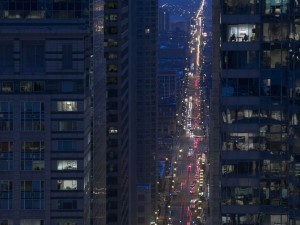
#85
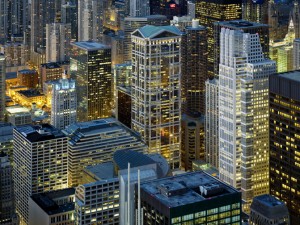
#11
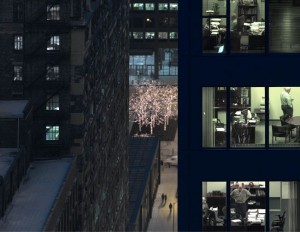
#76
late night business types in the office buildings, and people relaxing in the… um… “privacy” of their apartments. I took a closer look. No individual was really recognizable is these photos, nor were they doing anything that might cause them embarrassment (unless perhaps they weren’t supposed to be in that particular apartment). Ironically, in one photo (#88) you can make out a camera with a telephoto lens mounted on a tripod near the window.
Then Wolf takes it one step further. In his #28, he presents a photograph of four windows. Two are lit, giving the work an impression of a diptych. In one corner, pieces of a suit are tossed onto a chair in a bedroom. Through the window in the opposite corner, a man sits working at a desk. His shirt is off (presumably tossed on that chair), and he may be naked, except for his watch. His muscular torso is covered with tattoos. I would love a photo like this of myself. He’s fit, hip, and successful. Sure, he’s putting in a few extra hours of work at home (or maybe he’s just surfing the web), but he’s obviously got a life.
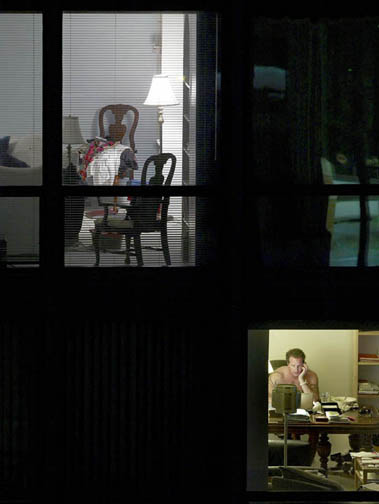
#28
Then I felt the beginning of a nagging suspicion. I asked one of the gallery staff if Wolf was working with models. He wasn’t. These were photos that were taken surreptitiously from another building into the workplace and dwellings of people, without their knowledge, where they had a reasonable expectation of privacy.
I’ve encountered situations before where if I had asked permission to take someone’s photo I would have ruined the scene I wanted to capture. In fact, in a public place I have the right to photograph people, even children, without their consent or the consent of their parent or guardian. But I wouldn’t do it. I know some photographers who will shoot first and ask permission afterwards, but I’ve not yet found a scene that would be worth it.
Regardless, this is not a public space, especially not the shots into the apartments. According to the Photographer’s Bill of Rights, written by Bert P. Krages II, an attorney residing in Oregon:
Property owners may legally prohibit photography on their premises but have no right to prohibit others from photographing their property from other locations….
Basically, anyone can be photographed without their consent except when they have secluded themselves in places where they have a reasonable expectation of privacy such as dressing rooms, restrooms, medical facilities, and inside their homes.
I’m not an attorney (but I play one on TV), and this is where it gets a bit confusing. Essentially Krages is saying that no one can be photographed without their consent in their homes, even though their home can be photographed from another location. Does an apartment not constitute one’s home? (We’ve learned from “Buffy the Vampire Slayer” and “Angel” that a vamp can enter a hotel room unbidden as it is not the occupant’s home, but I digress.)
However, another source qualifies the issue of needing permission, stating:
Publishing an identifiable photo of a person without a model release signed by that person can result in civil liability for whomever publishes the photograph…. Unless a photo is actually published, the need (or use) of a model release is undefined (http://en.wikipedia.org/wiki/Model_release).
I know what you’re wondering: Isn’t printing and exhibiting a photo the equivalent of publishing it? Actually, no. According to 17 USC 101:
A public performance or display of a work does not of itself constitute publication.
- (1) to perform or display it at a place open to the public or at any place where a substantial number of persons outside of a normal circle of a family and its social acquaintances is gathered….
It is possible that if they used that person’s image to advertise the exhibit then this might constitute its promoting a product or service, and then a model release would have been required (http://en.wikipedia.org/wiki/Model_release). But they didn’t, so it isn’t.
The legal tightrope walked by the artist and the gallery does not seem to be simply an unfortunate side-effect of doing what it takes to get and exhibit a good photo; The press release states:
Focusing entirely on the classic Chicago cityscape, Wolf directs his penetrating lens on an American city for the first time in The Transparent City. With this work Wolf offers images of human vulnerability coupled with the harsh sterility of modern life as seen through his unapologetic voyeurism and trademark architectural photographic style.
I think “penetrating” is an apt choice of words for Wolf’s, uh, lens. His #4 immediately reminded me of Brian De Palma’s famously misogynistic film, “Body Double” (2004).
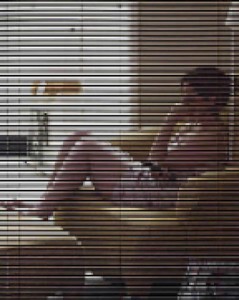
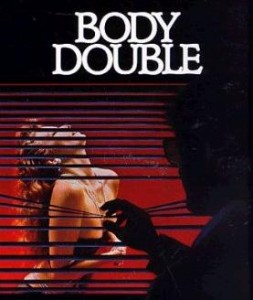
I think Wolf wants his work to be shocking. His architectural photos demonstrate great technical proficiency and a keen eye, but photos like #4, above, look more like a still from a home video, and do not stand up to the same scrutiny. Photos like that may have their place, but they simply do not belong with the others in this portfolio. They prevent the show from achieving any cohesiveness.
Most of Michael Wolf’s photos are pretty well done. Those are the photos that drew me to his exhibit. As for the others, apparently he is within his rights to profit from his voyeurism. But just because you can do a thing doesn’t mean you should.
If you’d like to view his work and decide for yourself, The Transparent City continues at the Robert Koch Gallery through January 31, 2009. Regardless of what Mutual Art says. While you’re there, check out Horace Bristol at Scott Nichols Gallery, which has been extended to January 13.
Michael Singman-Aste
Postdiluvian Photo
Tags: Horace Bristol, Michael Wolf, Robert Koch Gallery, San Francisco, Scott Nichols Gallery



Sounds like an interesting exhibit. With your photographer’s eye, you notice so much more in a photo than I do. I enjoyed experiencing the photos more deeply by reading your analyses of them.
[…] « Michael Wolf’s Penetrating Lens […]
[…] are other observer effects in photography. I mentioned in “Michael Wolf’s Penetrating Lens” that photographers encounter situations where if they stop to ask permission before taking […]